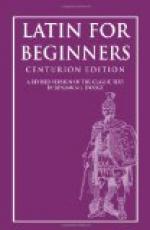512. Review Questions. What is conjugation? Name two important differences between conjugation in Latin and in English. What is tense? What is mood? What are the Latin moods? When do we use the indicative mood? Name the six tenses of the indicative. What are personal endings? Name those you have had. Inflect sum in the three tenses you have learned. How many regular conjugations are there? How are they distinguished? How is the present stem found? What tenses are formed from the present stem? What is the tense sign of the imperfect? What is the meaning of the imperfect? What is the tense sign of the future in the first two conjugations? in the last two? Before what letters is a final long vowel of the stem shortened? What are the three possible translations of a present, as of pugno? Inflect aro, sedeo, mitto, facio, and venio, in the present, imperfect, and future active. What forms of -io verbs of the third conjugation are like audio? what like rego? Give the rule for the dative with adjectives. Name the special intransitive verbs that govern the dative. What does the imperative mood express? How is the present active imperative formed in the singular? in the plural? What three verbs have a shortened present active imperative? Give the present active imperative of porto, deleo, ago, facio, munio.
IV. REVIEW OF LESSONS XXVII-XXXVI
513. Give the English of the following words:
NOUNS OF THE FIRST DECLENSION ala\ cura\ mora\ porta\ provincia\ vita\
NOUNS OF THE SECOND DECLENSION
animus\ navigium\
aurum oraculum
bracchium\ periculum\
deus\ ventus\
locus\ vinum\
monstrum
ADJECTIVES OF THE FIRST AND SECOND DECLENSIONS adversus\ dubius\ attentus maximus\ carus\ perfidus commotus\ plenus\ defessus\ saevus dexter\ sinister\
ADVERBS antea\ ita\ celeriter\ longe\ denique\




